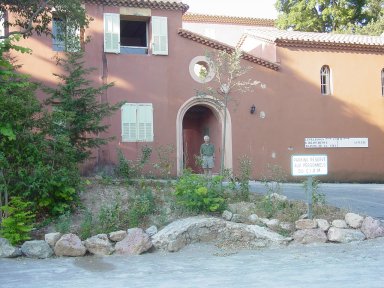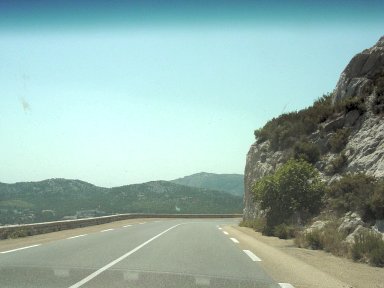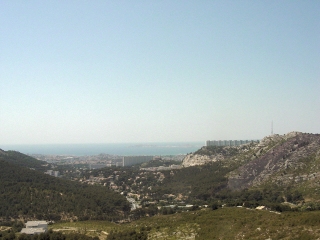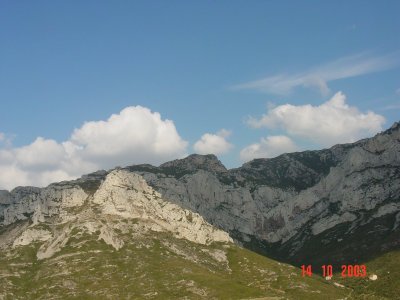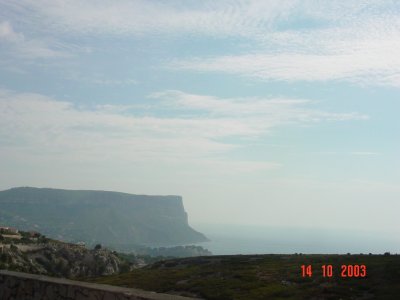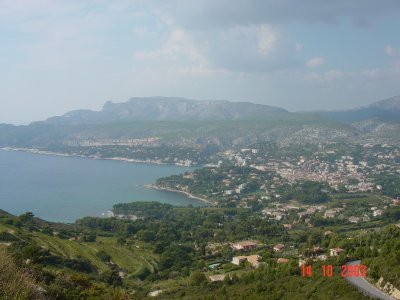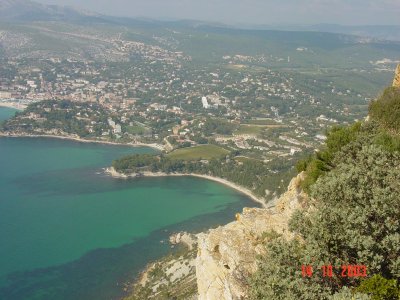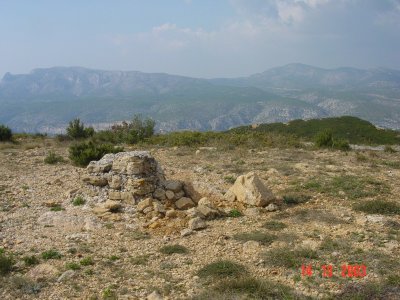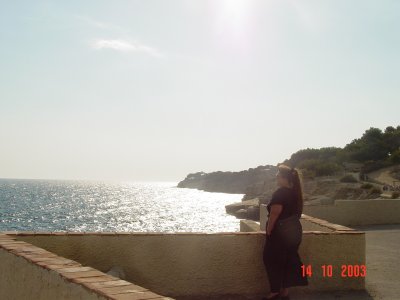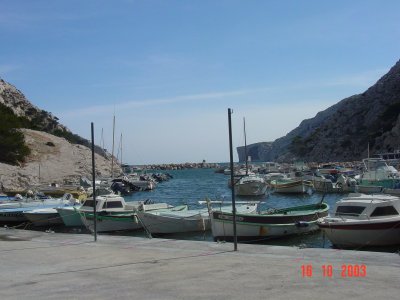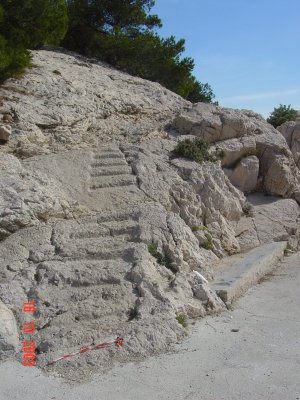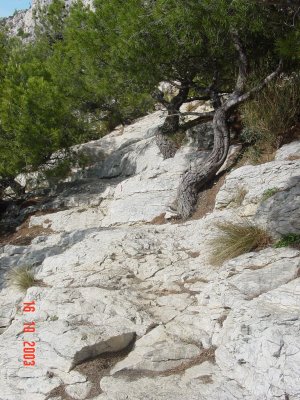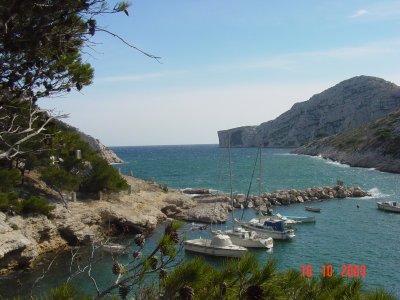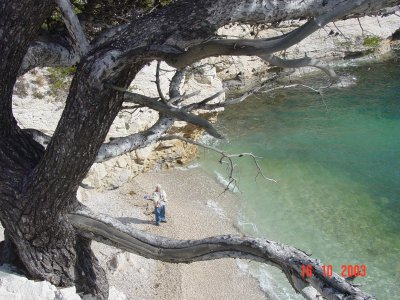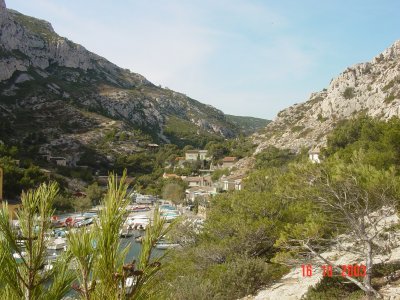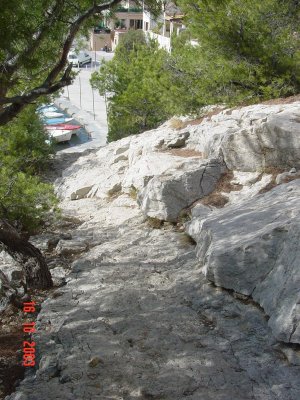In 1985, Henri Cosquer, a professional deep-sea diver from Cassis, France, discovered a cave approximately 120 feet below sea level at Cape Morgiou near Marseille. It was several years – 1991 – before the prehistoric paintings and engravings of the cave – above the waterline in a large chamber – were even noticed.
Ark and I spent the past week in Marseille at a CIRM conference where Ark was scheduled to speak. We didn’t have too much time for sightseeing due to the conference schedule, but we did manage to pay a visit to Cape Morgiou and Cassis. On our way home we also managed to visit the house of Nostradamus in Salon de Provence, but more on that will come as I can get it written. For the moment, I want to share with all of our readers some of the marvelous scenery of the region, as well as the great mystery of the Cosquer Cave.
| Above we see Ark standing at the entrance to the CIRM building where there are offices, conference facilities, guest quarters and a dining room presided over by a marvelous chef. CIRM – Centre International de Rencontres Mathematiques – is located in Luminy just to the East of Marseille. It is only a short drive to Cassis – the home of the man who gave his name to the Cosquer Cave. | ||||||||||||||||||||||||
| I took the above shot through the windshield of the car to give you an idea of what it is like to drive into and out of Marseille from Cassis. The road winds up and down the mountains and the strata of millions of years is evident where tectonic forces have sheared the mountains, carving stark valleys in a landscape that is thrilling in every sense of the word. | ||||||||||||||||||||||||
| If you look down from the road that runs between Marseille and Cassis, you can see Marseille… the view is marvelous at night… | ||||||||||||||||||||||||
| The views on either side are also breathtaking… | ||||||||||||||||||||||||
| Looking toward Cassis, we see our destination – Cap Canaille – the highest sea cliff in Europe, (nearly 400 meters / 1400 ft) high. | ||||||||||||||||||||||||
| As we climb the steep switch-back road up the Cap, we are able to look down on Cassis… | ||||||||||||||||||||||||
| We stopped half way up Cap Canaille to snap a photo of Cassis… | ||||||||||||||||||||||||
| And here is Cassis from the top of the cliffs… Notice the little beach in the smaller of the two bays above… we will soon be there… | ||||||||||||||||||||||||
| If you look straight down from the edge of the cliff, this is what you will see. The trees along the water’s edge are actually pretty big… | ||||||||||||||||||||||||
| As we were driving back to Cassis, I noticed an odd pile of rocks off to the right at the very top of Cap Canaille. We pulled off the road to inspect it and it certainly looked like some sort of altar. | ||||||||||||||||||||||||
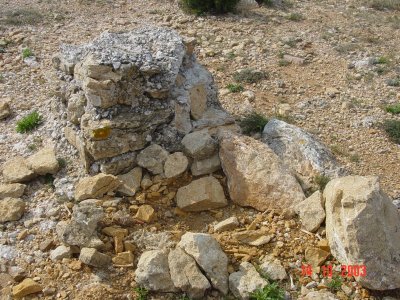 Obviously, strange things go on in France as elsewhere. A closer inspection of the “altar” revealed scattered bones and a clump of blondish hair.I was a little bit disturbed by the altar on the previous page – especially when we soon encountered a little poodle with exactly the same color fur at a cafe down in Cassis. Obviously, strange things go on in France as elsewhere. A closer inspection of the “altar” revealed scattered bones and a clump of blondish hair.I was a little bit disturbed by the altar on the previous page – especially when we soon encountered a little poodle with exactly the same color fur at a cafe down in Cassis.
Now, a bit about the Cosquer Cave. The peoples who left the marvelous art in this cave, according to the experts who have studied the matter, did not live in the caves. It is thought that they only went there to create art and perhaps conduct some sort of initiatory rites. Analyses have established what kind of wood they used for their torches and precise dates were obtained for pieces of charcoal lying on the cave floor as well as the charcoal lifted from some of the art. There are two series of date ranges: one about 27,000 years ago and the other at about 18,500 years ago. What this means is that the Cosquer Cave was visited during two periods only, with that odd interval of 8,500 years in between. The rock art from the older period consists of stencils of hands – with incomplete fingers – made by placing the hand against the wall, curving selected fingers, and then blowing pain around the hand to outline it in red or black. Also in that period, someone covered the walls and ceilings with grooves made in soft surfaces – presumably “finger tracings.” It was only in the second period of use that animals were painted and engraved. There are about a hundred pictures of animals recorded in the Cosquer Cave and most of them are horses, ibex, chamois, bovids and cervids. There is also a feline head and several animals that no one knows exactly what they represent. One of the unusual features of the Cosquer Cave is that sea animals are also depicted including eight seals, three great auks, a fish and jellyfish and even penguins. There are also geometric signs – rectangles, zigzags, and spear signs on some of the animal bodies. The art of the Cosquer Cave is parallel to the prehistoric art of Ebbou in the Ardeche region of France and with Parpallo in the area of Valencia, Spain. This suggests that the individuals responsible for this art traveled quite a bit and had extensive contacts. Many people have wondered what the people who created the great Cave Art of Europe looked like since they weren’t very interested in leaving portraits of themselves. A bit further to the East, along the Italian-French border, other caves contained a group of a dozen skeletons, nine of which were well-preserved. These individuals belonged to the classic Cro-Magnon type and are generally placed contemporary to the earlier works (phase one) in the Cosquer Cave. The only representatives of the Cosquer phase two period are some badly preserved skeletons from the Ardeche and Dordogne regions of France. These were also modern humans of the Cro-Magnon type which means that they were like us, only better. The reader may like to take a virtual tour of the Cosquer Cave. Originally Published 2003_10_18 |
Discover more from Cassiopaea
Subscribe to get the latest posts sent to your email.

